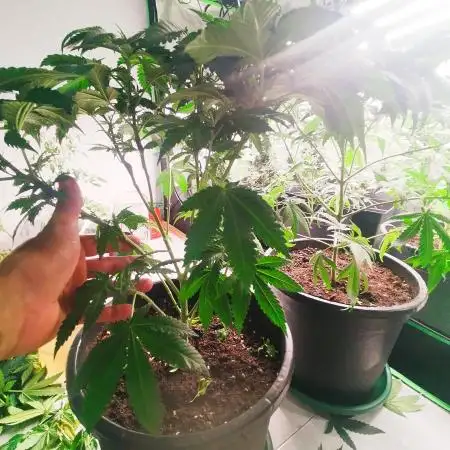By continuing to use the website or clicking Accept you consent to our cookies and personal data policy and confirm that you are at least 18 year old. For details please see Privacy Policy and Terms
Accept
Autoflowers/Light/Mars Hydro FC-e6500
HaanfSolostarted grow question 5mo ago
Im growing autoflowers and am unsure about the lights. I understand with photos but autos grow at their own rate, how should I control the light?
I have a Mars hydro FC-e6500. Which setting should I use? 50%, max? Which PPFD?
Open
Setup. Strain - Autoflowering
Setup. Lighting
likes
Answer
BC_Greenanswered grow question 5mo ago
This article answers that question and gives an awesome graph of DLI recommendations by week:
https://growlightmeter.com/autoflowering-cannabis-lighting/
Here is a calculator to convert PPFD to DLI:
https://www.waveformlighting.com/horticulture/daily-light-integral-dli-calculator
Happy growing!
likes
Complain
00110001001001111Oanswered grow question 5mo ago
Specific to your context:
You have a 5x4 tent = 20sq ft.
18h operation starting point range:
20 x 70 x .67 = 938
20 x 80 x .67 = 1072
Call it 950-1100 umol/s produced at diode with reflective walls and orthodox hanging distances.
FCE-6500 claims 2044umol/S
1100 / 2044 = about 54%.
So, yes, 50% would be a good starting point. You still need to observe and adjust no matter what you choose. In the end the plant and environment together dictate maximum DLI you can give.
-------------------------
Why... (or, learn to fish for yourself)
It's the same concepts and doesn't really change. You start around the same DLI and you allow the plant's growth to dictate adjustments for your local variables.
How much any plant can handle per day without hurting itself depends on several variables, therefore how much light you give will inevitably be different than how much someone else can provide, safely.
PPFD is only half the equation. That's like miles per hour (a rate alone is not entirely useful). That needs to be multipled by hours of operation (simplified). DLI tables can be found with a simple google image search for reference. Start somwhere around 35-40 DLI (ambient co2 conditions) and adjust based on plant growth -- too lanky? add more. too tight? reduce. Simple after that. If your temps, rh and atmospheric co2 remain consistent throughout the year, you can use the same settings and hanging distance. Otherwise, go through the same observe and adjust process for each seasonal change... take notes so you only have to do it once. Very minimal adjustments may be needed after that, unless you ahve some sort of professional lab control over your climate :P
12h operation, maybe 70-80umol/s per sq ft (umol/s at diode and orthodox hanging distance)
18h operation 67% of that rate needed to get to same DLI.
16h operation 75% of that rate needed to get to same DLI.
You can multiply that by 10.764 to get PPFD. (10.764ft^2 / 1m^2 onversion)
DLI is what matters. DLI is what needs to jive with your climate and atmospheric co2 to avoid damaging a plant. if you stick to standard hours of operation, you'll get just as familiar with your specific umol/s needs from light (at diode).
There is little to no difference with autoflowers compared to photoperiods except for how it switches to flower phase. No matter how good a suggestion is in regard to light intensity, you absolutely will have to make some minor adjsutments based on local variables. It may even take several weeks to see any symptoms of too much light.
1 like
Complain
GrowOffDutyanswered grow question 5mo ago
Tudo bem amigo? As suas Auto estão em qual semana?
likes
Complain
gREEn7o0answered grow question 5mo ago
What they said. Hit your DLI.
There's a good amount of DLI charts. One of the ones I refer to that seems to be alright is https://growlightmeter.com/lighting-requirements-of-cannabis-over-the-full-grow-cycle/
Each plant is different, some can handle more, some less.
1 like
Complain
UnkleSkunkanswered grow question 5mo ago
likes
Complain
kannafarmeranswered grow question 5mo ago
Hi growmie,
You should see the perfect DLI for each phase of the plant, it doesn't matter if it is an auto or a photo.
This is a calculation of the PPFD versus the amount of hours that your light is on. Usually for each phase you can use DLI for seedling - 15/20; ealry veg - 20/40; late veg - 30/40; early bloom - 40/44; full bloom - 35/40; rippening - 25/35
The idea is to simulate the amount of light through all the grow cicle. This are rederence values you can allways push it harder, specially if you have CO2. You can use the photon app to measure the PPFD and DLI through out the grow.
You can reach for this information on the buildasoil website on the education menu, environment conditions.
I hope it helped =)
Wish you good harvests
2 likes
Complain
All_our_small_plantsanswered grow question 5mo ago
Also autoflower ist wie jede Pflanze. Wenn du mit einer 18 Stunde Licht Phase die Genügende DLI erreichst dann reichen 18 Stunden, bei meinen Lampen reicht wenn ich sie dann auf 80% laufen lassen. Du kannst die DLI mit einer app messen die heißt Photone.
Hier ein paar Richtwerte
Keimlingsphase: 100–300 μmol/m²/s – Ähnlich wie bei Photoperioden-Pflanzen ist sanftes Licht ideal für junge Pflanzen. Das sind 10 bis 15 DLi
Vegetative Phase: 300–500 μmol/m²/s – Da Autoflowers eine kürzere vegetative Phase haben, reicht ein etwas niedrigerer Wert als bei herkömmlichen Pflanzen aus. So 30 bis 40 DLI sind hier ok
Blütephase: 500–750 μmol/m²/s – Autoflowers bevorzugen in der Blütephase oft geringfügig niedrigere PPFD-Werte als Photoperioden-Pflanzen hier kann mann da auf bis zu 45 gehen.
Das sind Werte die ich verwende und bei mir funktioniert es gut
4 likes
Complain
Ninjabudsanswered grow question 5mo ago
Well I’d start the plants just the same as photo plants. Depending on the strain of autos some go into flower right after being a seedling and some wait a few weeks so you really have to be on the lookout for the plant starting the stretch. When it starts to stretch slowly increase lighting. Then when you see flowers start to develop go back to the same amount of light you do for a photo i give them 20hrs of light during veg and 18hrs durring flower if you have a weak light you can give 20 or 22 hrs of light with some strains. Autos and very much random their not my cup of tea sometimes you get big plants some times you get mini plants
1 like
Complain
Similar Grow Questions
Solved

Scott_Tennerman
What kind of light level (lux) during the dark cycle will cause my plants to herm in the flowering stage?What kind of light level (lux) during the dark cycle will cause my plants to herm in the flowering stage? I am growing in my bathroom (no windows) and I am worried about external light entering. My bathroom has 3 LED (30W) bulbs in, I have removed the 2 closest to my plants.Setup. Lighting
5y ago
2
2
Solved

Growladyeastmidlands
What lights best to flower mars hydro 1600w or hps 600wSetup. Lighting
4y ago
2
4
Solved

Seratram
Does this causes light stress?Do you think these small Leds can cause light stress on my plants?
Setup. Lighting
5y ago
1
2
Solved

jimmminycricket
Seed helpWhat's the best place for seeds shipped to us for beginners preferably with ability to use credit card. ThanksSetup. Strain - Autoflowering
Setup. Seeds
5y ago
4
4
Solved

Tubington9
White and blurple led in same tent?I recently upgraded to a TS1000 for my flower tent, and am waiting on an SF1000D for my veg tent, and now have a tmlapy “1500w” blurple sitting around. Would i gain anything running the blurple and ts1000 in the same tent? Or is it not worth the extra energy consumptionSetup. Lighting
4y ago
1
1
Solved

DankCityCeo
Help pleaseDoes it matter if I have one white light led and one purple?🤷♂️🏾🙈Setup. Lighting
5y ago
1
1
Solved

GBaalr
Heat stress? Or something else?Good day everyoooneeeee 💚 ☘️
I'm wondering is this because of the heat in the tent. It's around 30-31 celsius . Leaves are curling up and there's not much growth. Can anyone help me out to identify the issue? It's an auto if week 4. Just gave her first round of nutes.
Leaves. Curl up
Leaves. Twisted
Setup. Strain - Autoflowering
4y ago
3
6
Solved

Newbie90
Temperature too highHey 👋 how do uns keep temperature down? I’m usually in 28,8.nothing helps to cool it down tried everything.have wet towels in tent spray water co2 bags one fan air out one in and 2fans on each corner. Light dual spec 600w. I’m scared to water more. Thanks 🙏Plant. Other
Setup. Strain - Autoflowering
Setup. Lighting
5y ago
9
8
Solved

Dragosani666
When to harvest?Beginner question:
Would you say this is ready to harvest soon or should I wait some more? Leaves turning autumn colors, 3/4 of pistils turned orange.
Trichomes look rather clear, but some on the head bud are amber already.
RQS says 8-9 weeks. Starting week 9 soon.
1y ago
8
6
Solved

girlwhogrows
MarsHydro FCE4800 for a 4x4 grow?Is the MARS HYDRO FC-E4800 480w the best option to use for my 4x4 tent. Will be doing 9 CBD auto flowers as a hobby.
Would you suggest any alternatives?
Really appreciate all the advice and will be making my purchase with the advice you have all given me so far!
Setup. Lighting
1y ago
1
5
Solved

Jaxx_Teller
Power and distanceOk so......
This is a Mars Hydro TSW2000 specific question.
1, When should i go 100% with the light as far as plant age is concerned?
2, I've seen various distance tables that all vary so i'm asking TSW2000 growers specifically what their distances are for Autos.
Many thanksWeek 5
Setup. Lighting
5y ago
2
4
Solved

MangJs
HLG 350R or ES300 V3 ??Hi Growmies,
planning on adding an additional light on my 4x8 I currently have 1x HLG 650R running, but need your opinion if I should go for HLG350R or ES300 V3 ( Green sunshine Co ) whats your thoughts? i want to leave quarter space inside to work on and also to put some equipSetup. Lighting
4y ago
3
3
Solved

MrGreen92
Mars Hyrdo TS600 - 100w but mistook for 600wI've recently found out that the led light I have which is a Mars Hydro TS600 is not in fact 600w and is actually 100w.
Do I need to compensate in any way? My plants look healthy but short, I don't want to put the light too far away that it's ineffective, how close is too close?2y ago
3
3
Solved

NewJackWeed
Does this Gold Leaf auto need to be thinned or SCROG'ed?Should I thin her out? Should I SCROG? Does she look healthy? I've done a lot of LST and water with a pH 6. She's a Gold Leaf autoflower at 7 weeks, 2 days.
Leaves. Too many
Plant. Twisted
Setup. Strain - Autoflowering
5y ago
2
4






















